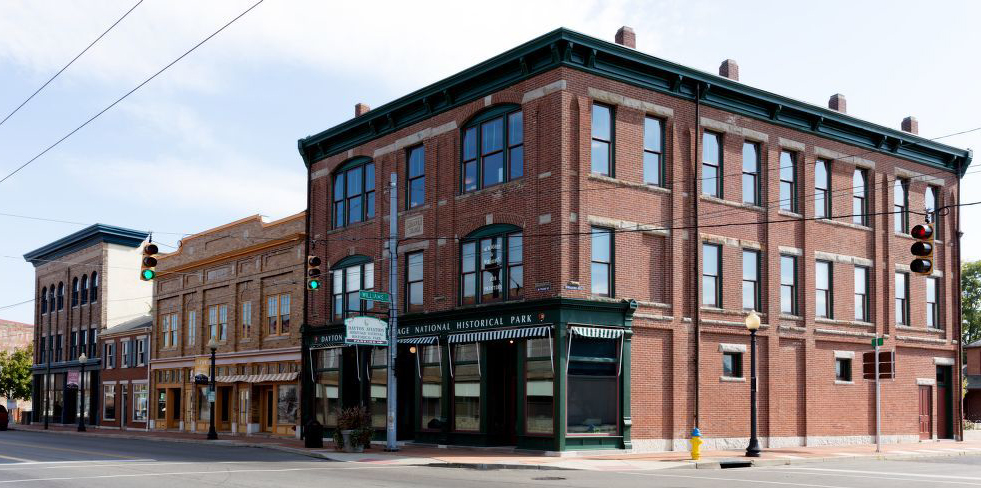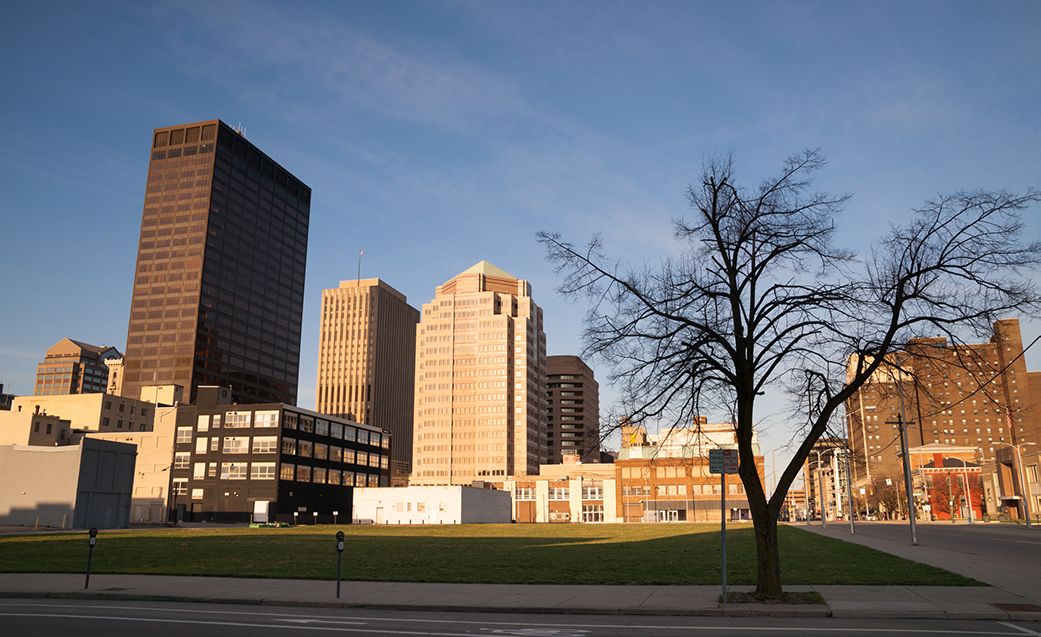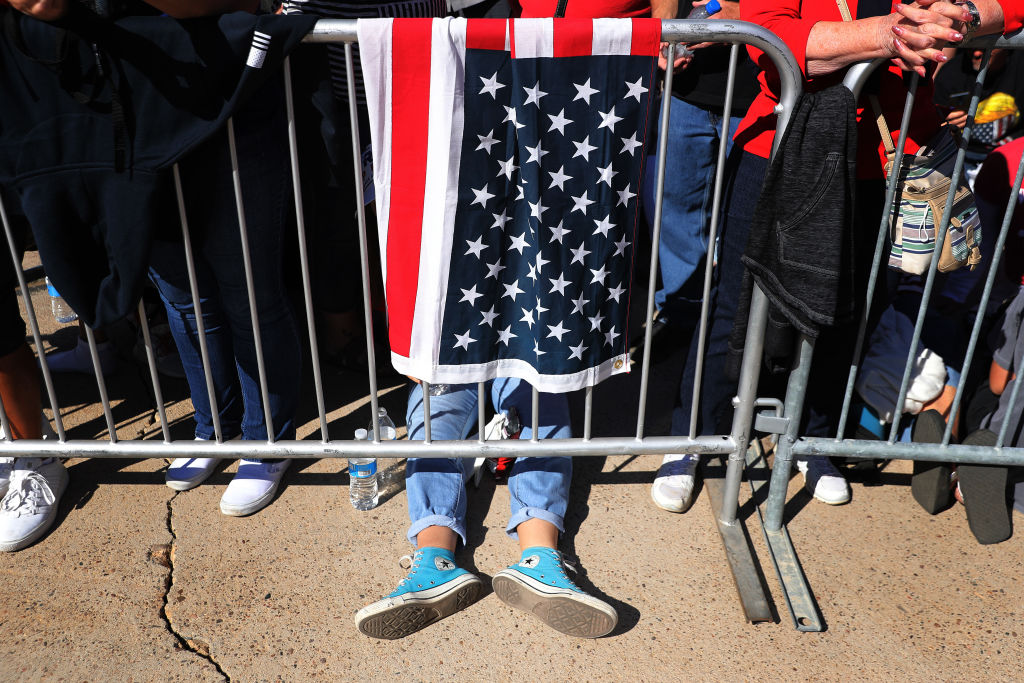Cars are a more common sight than people on Dayton’s West Third Street, a major boulevard known as the heart of the Black community in this Ohio city. Once a bustling commercial corridor, West Third has become synonymous with empty buildings and urban neglect over the years, as local businesses have closed down and the neighborhood’s fortunes have waxed and waned.
Named after three of Dayton’s most famous sons, the Wright Brothers and Black poet Paul Laurence Dunbar, the Wright-Dunbar neighborhood has struggled with segregation and decline. However, the recent opening of Chanta Winston’s store may have sparked a flicker of hope here, at a time when Black Americans have been disproportionately impacted by COVID-19 and protests have roiled the country after the killing of George Floyd in late May.
“I feel new beginnings,” the 33-year-old Daytonian says with a big smile. Standing outside her new retail boutique called The Entrepreneurs’ Shoppe, Winston greets dozens of customers and friends filing into the store, where a colorful explosion of hand-painted shirts, funky hats, summer dresses and beauty products meets their eyes. Vendors will rotate each week at The Shoppe, which she describes as a “small mall” where people can buy local and discover Dayton’s entrepreneurial talent. Amid the uncertainty, Winston said she wanted to “bring some light back” into the area.
This is one in a series of three articles on regions of the country that never fully recovered from the Great Recession and that are located in critical battleground states. In 2019, Dayton was one of 104 metro areas in the U.S. that had fewer jobs than it did prior to the Great Recession, according to a Brookings Institution analysis.
Across Dayton, people have been protesting against systemic racism and injustice, and nowhere are these realities more evident or more stark than in Wright-Dunbar. The Great Miami River bisects the post-industrial city from north to south and marks a cultural divide between Black and white Dayton. Mobilizing Black Daytonians like Winston who are passionate about uplifting their communities could help turn Montgomery County blue, a crucial swing county that narrowly went for Donald Trump in 2016 after decades as a Democratic stronghold. And in a district where more Black voters turned out for Hillary Clinton in 2016 than voted in 2012 in one precinct, the mobilization of Black women could prove even more significant to the upcoming elections, as this battleground state becomes competitive again electorally.
And yet, historic struggles remain for the local African American community. Thirty-nine percent of Dayton’s residents are Black. West Dayton encompasses a large geographic area that suffers from a history of economic segregation, poverty and redlining. In Dayton, more than 40 percent of Black residents who are poor live in high poverty neighborhoods, further limiting their access to resources and economic opportunity. In Montgomery County, the percentage of Black residents living below the poverty level is also more than twice as high compared to whites, according to a 2019 public health community assessment.
In May, about 3 percent of African American residents in Montgomery County applied for unemployment as a result of the pandemic. Over 40 percent of Black-owned businesses have been forced to close down nationwide. And like many cities throughout the country, Dayton has been wracked with anger and unrest since Floyd’s brutal death at the hands of a Minnesota police officer.
Will the economic struggle brought on by the COVID-19 pandemic — coupled with newfound energy in the community brought on by mass protest and efforts at economic revival — transform voter turnout among African American voters in November?

At the opening event of The Entrepreneurs’ Shoppe in early June, the mood seems calm and almost optimistic. Winston says she generally tries to steer clear of politics, but she also wants somebody to fight for her community. “Everything we make, we pour back into the neighborhood. Because what I do isn’t just for me, it’s to give back and help feed families.” Winston recently worked with a group of young Black professionals to provide hundreds of meals to West Dayton residents while also giving out voter registration cards. Per a 2019 Montgomery County public health assessment, 26 percent of low-income residents in the city’s southwest area don’t live within 1 mile of a supermarket — the highest percentage of food-insecure residents reported in the county. (Aldi was one of the last grocery chains to serve West Dayton until it closed in 2018, leaving residents without access to fresh and healthy food options.)
“I always vote,” says 49-year-old Felicia McGuire, who runs a hair salon around the corner from The Shoppe. She plans to vote for Joe Biden this fall. “People died so we could vote. That’s the only way that things have the potential to change.” Black people generally vote at high rates, but in 2016, Black voter turnout across the country dropped significantly, says the Brookings Institution.
McGuire’s priority is to get Trump out of office. And the longtime salon owner would like government assistance to cover rent over the next few months. Since most of her clients are over 40 and particularly vulnerable to the coronavirus, it’s been a struggle to keep her doors open. For now, she is moving forward with a partial reopening.
“We have about 100,000 people dead and still counting,” McGuire says. She is mindful of opening up at a time when her own community has been hit hard by the virus. “It’s like [other people say]: Why would we keep our businesses closed and shut our economy down when it’s just people of color dying?”
In Ohio, African Americans make up 25 percent of COVID-19 cases, even though they represent only 13 percent of the state's population.
In Ohio, African Americans make up 25 percent of all COVID-19 cases and 17 percent of coronavirus-related deaths, even though they represent only 13 percent of the state’s population. Recent data also show the Dayton metro area has the highest COVID-19 reproduction rate in Ohio, which means that more new coronavirus infections are stemming from one single case in Dayton than in any other part of the state.
Property manager Erica Hubler says she isn’t planning to kick out any of her tenants. “The pandemic is not something they could have any control over. So we’re just going to take a hit this year,” she adds. She has shared information about federal pandemic assistance programs and helped some of her tenants apply for grants, but no one has heard back so far. (Black-owned businesses are more likely to face structural barriers that may ultimately compromise their ability to acquire an initial Paycheck Protection Program [PPP] loan, per a Center for Responsible Lending report.)
“This is going to be a process, because until we have a vaccine, people are not going to feel a hundred percent comfortable being in a public space,” McGuire admits. As an independent contractor who does not qualify for unemployment, and whose application for the PPP then got denied by the government, she calls the whole experience traumatic.
“After not being able to work for a couple months, to have something is better than nothing,” McGuire adds.
OUT OF TOUCH
The federal stimulus has largely remained out of reach to independent contractors because it does not reflect the realities of today’s market, says labor organizer Lela Klein. Klein runs Co-op Dayton, a progressive nonprofit that encourages workers to own and run their own businesses. Since the Great Recession in 2007, many people have started small, home-based businesses or worked several side hustles to make up for the lack of sustainable employment, she says.
“The stimulus imagines an economy of 20 years ago where people are the employees of a single employer and make W-2 wages. Those are the folks best able to get unemployment insurance or to have their jobs saved by a program like PPP,” Klein notes.
Rapid economic changes have also left the formerly booming industrial city of Dayton in the dust. For decades, Dayton has been transitioning from an almost exclusive dependence on manufacturing to a more diversified local economy that includes the service, health care and aerospace industries. (The Wright-Patterson Air Force Base, which is located east of the city, remains the area’s largest employer, but local activists maintain it’s disconnected from the rest of the city.) The huge companies that once dominated Dayton, notably National Cash Register Corporation (NCR) and General Motors, have left or closed down following a general trend of manufacturing decline apparent since the 1960s, the effects of which were only exacerbated by the Great Recession.
The huge companies that once dominated Dayton, notably National Cash Register Corporation and General Motors, have left or closed down.
But while area unemployment has decreased overall since 2007, Klein says wages still haven’t caught up with pre-recession numbers and economic growth remains slow, leaving many Daytonians behind. “I know people who were laid off from GM went and got some kind of an IT-based job training program that was provided with federal dollars,” she adds. “They couldn’t find a job on the other end and now are bartending at a casino.”
Daytonians still remember what it was like to have a thriving blue-collar sector, and what happens when big corporations like GM and NCR leave the area, says Klein. The locals’ growing disaffection toward government also became more evident, she says, when she was canvassing for a local election in 2013 and found a lot of doors getting slammed in her face.
“You’ve got these potholes and rec centers that aren’t able to have the level of services that you see in the suburbs. And so these people are just feeling generally angry and distrustful of the major institutions,” Klein notes.
A 2018 report brings fresh attention to the devastating effects of white flight on Dayton, which deepened racial and economic divides in the city. After most factories relocated to the suburbs in the 1970s, Southern Black migrants who settled in West Dayton faced joblessness, a lack of resources and physical separation from the rest of the city, a worsening economic condition that was entrenched by the new interstate highway system, which facilitated access to the suburbs.

Prior to that time period, West Dayton had already been an impoverished area, and in 1966, massive civil unrest unfolded after a white man shot a 40-year-old Black man named Lester Mitchell outside of Mitchell’s West Dayton home in broad daylight. The ensuing unrest resulted in the decimation of the Wright-Dunbar business district. To this day, Dayton ranks as one of the top 20 most racially segregated cities in the country.
While imperfect, the manufacturing industry had traditionally provided a pathway to the middle class for Black Daytonians, offering decent-paying and often high-quality jobs for those with limited resources, experts say.
“The benefit to working in manufacturing for Black workers has actually been greater in terms of what they could be making in manufacturing versus another industry,” says Policy Matters Ohio researcher Michael Shields. Montgomery County lost almost 60 percent of its manufacturing jobs from 1990 to 2016. The area’s deindustrialization has also disproportionately impacted Black residents.
“I think manufacturing retention is part of the solution, but we also need to enhance the quality of the jobs we have,” Shields adds. Ohio currently ranks third in the nation for manufacturing jobs after California and Texas. He notes that state and local governments could invest in education and infrastructure to make sure manufacturing remains in the state.
Ultimately, however, “we have to reimagine Ohio’s economy,” says Prentiss Haney, a Dayton native and co-executive director of the Ohio Organizing Collaborative.
“Cities live and thrive based on the resources that it can give to residents. There’s not enough money to support families in Dayton right now, and part of that is because the economy of Ohio has radically shifted,” Haney says.
THE PRESENT
The gradual revitalization of Wright-Dunbar, with its focus on local entrepreneurship, could prove to be a new model for healthy neighborhoods. And promoting Dayton businesses could help reduce the city’s longtime reliance on large multinationals and corporations to drive its economy, according to labor advocates like Klein.
However, left unmanaged, the changes could lead to the erasure of the neighborhood’s culture and history should a thriving Wright-Dunbar undergo gentrification.
“Dunbar is primed to be the next area that people will want to move into,” Haney says. A born-and-bred resident of West Dayton, his parents used to own a soul food restaurant on West Third Street. “I’m a little bit concerned about the economic recovery of that area and its vibrant history being somewhat threatened by not being able to recover [from COVID-19]. Other corporate entities could come in and change the makeup of that neighborhood.”
Interest in redeveloping the West Third business corridor has increased significantly in recent years. A large-scale food hall with a coffee bar, along with a new brewery, are in the works. Several buildings along the corridor have also sold, including one slated for market-rate condos and retail. And as a proposed solution to the neighborhood’s food insecurity problems, a new grocery co-op will soon start construction less than a mile south of West Third Street.
“There has been a level of majority population integration in that area that really did start off as being a space that was a landing for African American or minority community, and that has changed,” says YWCA Dayton CEO Shannon Isom. “So I think we just need to be mindful.”
To manage the effects of gentrification, conservative economist Adam Millsap suggests something called “incremental redevelopment” — the idea of investing in smaller-scale projects that would lead to a neighborhood’s gradual transformation over time.
“Ultimately, we want these neighborhoods to improve, right?” asks Millsap, who has extensively studied Dayton’s economic history. “We want there to be more jobs, work or dining options, more grocery stores. And that’s necessarily going to attract people. So you just need to allow the housing supply to adjust in an incremental way so that you don’t get big price increases.”
But local entrepreneurship is only a piece of the puzzle. Building on the service and home care industries, which have since replaced the manufacturing jobs for Black Daytonians, would also improve Dayton’s economy. So would working with the state government to raise the minimum wage and increasing worker protection laws, among other strategies, according to Policy Matters Ohio.
Imagining a new vision for Dayton — and pushing for its realization — is where Haney’s work comes in. He’s been a community organizer for the last 10 years.
And it was his parents, who started their soul food joint out of necessity after being laid off from GM, who ultimately inspired the 28-year-old to start advocating for Dayton’s Black residents.
“You’ve gotta be a little bit entrepreneurial to go out and want to change the world. And you’ve gotta figure out the things that don’t exist yet,” Haney says. “Seeing my parents do that directed me in my life about what was possible for me, because I saw them make their dreams come true. Even when the city was starting to decline, they found a path.”
Copyright 2020 Capital & Main





